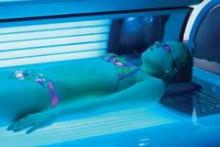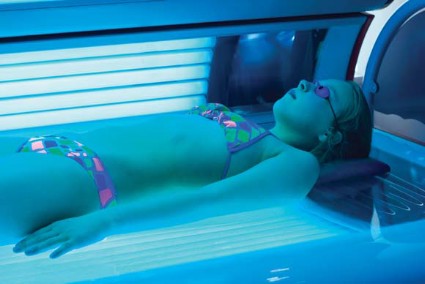User login
The Food and Drug Administration is requiring all tanning beds to carry a "black box" warning that the devices should not be used by children under age 18 years.
The labeling doesn’t carry any penalties for allowing teens to use tanning beds, but FDA officials said it sends a signal about their safety to the public.
"It reflects a very strong statement by FDA that we do not believe [tanning beds] should be used in individuals under the age of 18 because of the evidence that cumulative exposure to UV radiation is harmful to individuals and increases the likelihood of skin cancers, including melanoma," said Nancy Stade, deputy director for policy at the FDA’s Center for Devices and Radiological Health.
Agency officials did not rule out taking further actions to restrict tanning bed use in the future.
In a final order released on May 29, the FDA reclassified sunlamp products and ultraviolet (UV) lamps intended for use in sunlamp products from class I (low-risk) to class II (moderate-risk) devices. The regulatory change allows the agency to require tanning bed manufacturers to submit a premarket notification, also called a 510(k) submission, prior to marketing the devices. The premarket notification process requires manufacturers to show that their products meet certain performance testing requirements.
The new classification also allows FDA to require more stringent labeling of tanning beds.
The FDA is ordering all tanning beds to prominently display a black box warning on the device that states "Attention: This sunlamp product should not be used on persons under the age of 18 years."
Marketing materials including websites, brochures, and user instructions must carry four additional warning statements under the new FDA order. The warning statements include:
• Contraindication: This product is contraindicated for use on persons under the age of 18 years.
• Contraindication: This product must not be used if skin lesions or open wounds are present.
• Warning: This product should not be used on individuals who have had skin cancer or have a family history of skin cancer.
• Warning: Persons repeatedly exposed to UV radiation should be regularly evaluated for skin cancer.
In strengthening the warning label for tanning beds, the FDA cited statistics from the American Academy of Dermatology that individuals who have been exposed to UV radiation from indoor tanning experience a 59% increase in their risk of melanoma. The risk increases each time an individual uses a sunlamp product, according to the AAD.
The new rules take effect 90 days after their official publication on June 2. For new tanning devices, manufacturers must begin submitting 510(k) notifications after the effective date of the regulation. For devices that are already on the market, manufacturers have 450 days to submit their 510(k) notification and comply with the new labeling requirements.
Physician groups, including the AAD, praised the increased regulation of tanning beds.
"Restricting teens’ access to indoor tanning is critical to preventing skin cancer," Dr. Brett M. Coldiron, president of the AAD, said in a statement. "As medical doctors who diagnose and treat skin cancer, dermatologists are committed to reducing its incidence and saving lives. Therefore, we will continue to communicate to the FDA the need for stricter regulations on the use and sale of indoor tanning devices for minors under the age of 18."
On Twitter @maryellenny
The Food and Drug Administration is requiring all tanning beds to carry a "black box" warning that the devices should not be used by children under age 18 years.
The labeling doesn’t carry any penalties for allowing teens to use tanning beds, but FDA officials said it sends a signal about their safety to the public.
"It reflects a very strong statement by FDA that we do not believe [tanning beds] should be used in individuals under the age of 18 because of the evidence that cumulative exposure to UV radiation is harmful to individuals and increases the likelihood of skin cancers, including melanoma," said Nancy Stade, deputy director for policy at the FDA’s Center for Devices and Radiological Health.
Agency officials did not rule out taking further actions to restrict tanning bed use in the future.
In a final order released on May 29, the FDA reclassified sunlamp products and ultraviolet (UV) lamps intended for use in sunlamp products from class I (low-risk) to class II (moderate-risk) devices. The regulatory change allows the agency to require tanning bed manufacturers to submit a premarket notification, also called a 510(k) submission, prior to marketing the devices. The premarket notification process requires manufacturers to show that their products meet certain performance testing requirements.
The new classification also allows FDA to require more stringent labeling of tanning beds.
The FDA is ordering all tanning beds to prominently display a black box warning on the device that states "Attention: This sunlamp product should not be used on persons under the age of 18 years."
Marketing materials including websites, brochures, and user instructions must carry four additional warning statements under the new FDA order. The warning statements include:
• Contraindication: This product is contraindicated for use on persons under the age of 18 years.
• Contraindication: This product must not be used if skin lesions or open wounds are present.
• Warning: This product should not be used on individuals who have had skin cancer or have a family history of skin cancer.
• Warning: Persons repeatedly exposed to UV radiation should be regularly evaluated for skin cancer.
In strengthening the warning label for tanning beds, the FDA cited statistics from the American Academy of Dermatology that individuals who have been exposed to UV radiation from indoor tanning experience a 59% increase in their risk of melanoma. The risk increases each time an individual uses a sunlamp product, according to the AAD.
The new rules take effect 90 days after their official publication on June 2. For new tanning devices, manufacturers must begin submitting 510(k) notifications after the effective date of the regulation. For devices that are already on the market, manufacturers have 450 days to submit their 510(k) notification and comply with the new labeling requirements.
Physician groups, including the AAD, praised the increased regulation of tanning beds.
"Restricting teens’ access to indoor tanning is critical to preventing skin cancer," Dr. Brett M. Coldiron, president of the AAD, said in a statement. "As medical doctors who diagnose and treat skin cancer, dermatologists are committed to reducing its incidence and saving lives. Therefore, we will continue to communicate to the FDA the need for stricter regulations on the use and sale of indoor tanning devices for minors under the age of 18."
On Twitter @maryellenny
The Food and Drug Administration is requiring all tanning beds to carry a "black box" warning that the devices should not be used by children under age 18 years.
The labeling doesn’t carry any penalties for allowing teens to use tanning beds, but FDA officials said it sends a signal about their safety to the public.
"It reflects a very strong statement by FDA that we do not believe [tanning beds] should be used in individuals under the age of 18 because of the evidence that cumulative exposure to UV radiation is harmful to individuals and increases the likelihood of skin cancers, including melanoma," said Nancy Stade, deputy director for policy at the FDA’s Center for Devices and Radiological Health.
Agency officials did not rule out taking further actions to restrict tanning bed use in the future.
In a final order released on May 29, the FDA reclassified sunlamp products and ultraviolet (UV) lamps intended for use in sunlamp products from class I (low-risk) to class II (moderate-risk) devices. The regulatory change allows the agency to require tanning bed manufacturers to submit a premarket notification, also called a 510(k) submission, prior to marketing the devices. The premarket notification process requires manufacturers to show that their products meet certain performance testing requirements.
The new classification also allows FDA to require more stringent labeling of tanning beds.
The FDA is ordering all tanning beds to prominently display a black box warning on the device that states "Attention: This sunlamp product should not be used on persons under the age of 18 years."
Marketing materials including websites, brochures, and user instructions must carry four additional warning statements under the new FDA order. The warning statements include:
• Contraindication: This product is contraindicated for use on persons under the age of 18 years.
• Contraindication: This product must not be used if skin lesions or open wounds are present.
• Warning: This product should not be used on individuals who have had skin cancer or have a family history of skin cancer.
• Warning: Persons repeatedly exposed to UV radiation should be regularly evaluated for skin cancer.
In strengthening the warning label for tanning beds, the FDA cited statistics from the American Academy of Dermatology that individuals who have been exposed to UV radiation from indoor tanning experience a 59% increase in their risk of melanoma. The risk increases each time an individual uses a sunlamp product, according to the AAD.
The new rules take effect 90 days after their official publication on June 2. For new tanning devices, manufacturers must begin submitting 510(k) notifications after the effective date of the regulation. For devices that are already on the market, manufacturers have 450 days to submit their 510(k) notification and comply with the new labeling requirements.
Physician groups, including the AAD, praised the increased regulation of tanning beds.
"Restricting teens’ access to indoor tanning is critical to preventing skin cancer," Dr. Brett M. Coldiron, president of the AAD, said in a statement. "As medical doctors who diagnose and treat skin cancer, dermatologists are committed to reducing its incidence and saving lives. Therefore, we will continue to communicate to the FDA the need for stricter regulations on the use and sale of indoor tanning devices for minors under the age of 18."
On Twitter @maryellenny

